Prospective Observational Study to Evaluate the Effect of Different Levels of Positive End-Expiratory Pressure on Lung Mechanics in Patients with and without Acute Respiratory Distress Syndrome
Abstract
1. Background
2. Methods
2.1. Trial Design
2.2. Measurements and Calculations
2.3. Study Protocol
2.3.1. Measurement Errors and Cancellations
2.3.2. Premature Study Exclusions
2.4. Statistical Analysis
3. Results
4. Discussion
5. Limitations
6. Conclusions
Supplementary Materials
Author Contributions
Funding
Conflicts of Interest
References
- Slutsky, A.S.; Ranieri, V.M. Ventilator-induced lung injury. N. Engl. J. Med. 2013, 369, 2126–2136. [Google Scholar] [CrossRef] [PubMed]
- Protti, A.; Cressoni, M.; Santini, A.; Langer, T.; Mietto, C.; Febres, D.; Chierichetti, M.; Coppola, S.; Conte, G.; Gatti, S.; et al. Lung stress and strain during mechanical ventilation: Any safe threshold? Am. J. Respir. Crit. Care Med. 2011, 183, 1354–1362. [Google Scholar] [CrossRef] [PubMed]
- Bellani, G.; Laffey, J.G.; Pham, T.; Fan, E.; Brochard, L.; Esteban, A.; Gattinoni, L.; Van Haren, F.; Larsson, A.; McAuley, D.F.; et al. Epidemiology, Patterns of Care, and Mortality for Patients with Acute Respiratory Distress Syndrome in Intensive Care Units in 50 Countries. JAMA 2016, 315, 788–800. [Google Scholar] [CrossRef] [PubMed]
- Fan, E.; Del Sorbo, L.; Goligher, E.C.; Hodgson, C.L.; Munshi, L.; Walkey, A.J.; Adhikari, N.K.J.; Amato, M.B.P.; Branson, R.; Brower, R.G.; et al. An official American Thoracic Society/European Society of Intensive Care Medicine/Society of Critical Care Medicine Clinical Practice Guideline: Mechanical Ventilation in Adult Patients with Acute Respiratory Distress Syndrome. Am. J. Respir. Crit. Care Med. 2017, 195, 1253–1263. [Google Scholar] [CrossRef]
- Rackley, C.R.; MacIntyre, N.R. Low Tidal Volumes for Everyone? Chest 2019, 156, 783–791. [Google Scholar] [CrossRef]
- Brower, R.G.; Lanken, P.N.; MacIntyre, N.; Matthay, M.A.; Morris, A.; Ancukiewicz, M.; Schoenfeld, D.; Thompson, B.T.; The National Heart, Lung, and Blood Institute ARDS Clinical Trials Network. Higher versus lower positive end-expiratory pressures in patients with the acute respiratory distress syndrome. N. Engl. J. Med. 2004, 351, 327–336. [Google Scholar]
- Acute Respiratory Distress Syndrome Network; Brower, R.G.; Matthay, M.A.; Morris, A.; Schoenfeld, D.; Thompson, B.T.; Wheeler, A. Ventilation with lower tidal volumes as compared with traditional tidal volumes for acute lung injury and the acute respiratory distress syndrome. N. Engl. J. Med. 2000, 342, 1301–1308. [Google Scholar]
- Writing Group for the PReVENT Investigators; Simonis, F.D.; Neto, A.S.; Binnekade, J.M.; Braber, A.; Bruin, K.C.M.; Determann, R.M.; Goekoop, G.J.; Heidt, J.; Horn, J.; et al. Effect of a Low vs. Intermediate Tidal Volume Strategy on Ventilator-Free Days in Intensive Care Unit Patients without ARDS: A Randomized Clinical Trial. JAMA 2018, 320, 1872–1880. [Google Scholar]
- Talmor, D.; Sarge, T.; Malhotra, A.; O’Donnell, C.R.; Ritz, R.; Lisbon, A.; Novack, V.; Loring, S.H. Mechanical ventilation guided by esophageal pressure in acute lung injury. N. Engl. J. Med. 2008, 359, 2095–2104. [Google Scholar] [CrossRef]
- Loring, S.H.; O’Donnell, C.R.; Behazin, N.; Malhotra, A.; Sarge, T.; Ritz, R.; Novack, V.; Talmor, D. Esophageal pressures in acute lung injury: Do they represent artifact or useful information about transpulmonary pressure, chest wall mechanics, and lung stress? J. Appl. Physiol. 2010, 108, 515–522. [Google Scholar] [CrossRef]
- Malbrain, M.L.; Wilmer, A. The polycompartment syndrome: Towards an understanding of the interactions between different compartments! Intensive Care Med. 2007, 33, 1869–1872. [Google Scholar] [CrossRef] [PubMed]
- Force, A.D.T.; Ranieri, V.M.; Rubenfeld, G.D.; Thompson, B.T.; Ferguson, N.D.; Caldwell, E.; Fan, E.; Camporota, L.; Slutsky, A.S. Acute respiratory distress syndrome: The Berlin Definition. JAMA 2012, 307, 2526–2533. [Google Scholar]
- Baydur, A.; Behrakis, P.K.; Zin, W.A.; Jaeger, M.; Milic-Emili, J. A simple method for assessing the validity of the esophageal balloon technique. Am. Rev. Respir. Dis. 1982, 126, 788–791. [Google Scholar] [PubMed]
- Mojoli, F.; Iotti, G.A.; Torriglia, F.; Pozzi, M.; Volta, C.A.; Bianzina, S.; Braschi, A.; Brochard, L. In vivo calibration of esophageal pressure in the mechanically ventilated patient makes measurements reliable. Crit. Care 2016, 20, 1–9. [Google Scholar] [CrossRef] [PubMed]
- Grieco, D.L.; Chen, L.; Brochard, L. Transpulmonary pressure: Importance and limits. Ann. Transl. Med. 2017, 5, 14. [Google Scholar] [CrossRef] [PubMed]
- Olegard, C.; Sondergaard, S.; Houltz, E.; Lundin, S.; Stenqvist, O. Estimation of functional residual capacity at the bedside using standard monitoring equipment: A modified nitrogen washout/washin technique requiring a small change of the inspired oxygen fraction. Anesth. Analg. 2005, 101, 206–212. [Google Scholar] [CrossRef]
- Malbrain, M.L.; Deeren, D.H. Effect of bladder volume on measured intravesical pressure: A prospective cohort study. Crit. Care 2006, 10, R98. [Google Scholar] [CrossRef]
- Andrews, P.L.; Sadowitz, B.; Kollisch-Singule, M.; Satalin, J.; Roy, S.; Snyder, K.; Gatto, L.A.; Nieman, G.F.; Habashi, N.M. Alveolar instability (atelectrauma) is not identified by arterial oxygenation predisposing the development of an occult ventilator-induced lung injury. Intensive Care Med. Exp. 2015, 3, 1–12. [Google Scholar] [CrossRef]
- Caironi, P.; Cressoni, M.; Chiumello, D.; Ranieri, M.; Quintel, M.; Russo, S.G.; Cornejo, R.; Bugedo, G.; Carlesso, E.; Russo, R.; et al. Lung opening and closing during ventilation of acute respiratory distress syndrome. Am. J. Respir. Crit. Care Med. 2010, 181, 578–586. [Google Scholar] [CrossRef]
- Steinberg, J.M.; Schiller, H.J.; Halter, J.M.; Gatto, L.A.; Lee, H.M.; Pavone, L.A.; Nieman, G.F. Alveolar instability causes early ventilator-induced lung injury independent of neutrophils. Am. J. Respir. Crit. Care Med. 2004, 169, 57–63. [Google Scholar] [CrossRef]
- Cressoni, M.; Cadringher, P.; Chiurazzi, C.; Amini, M.; Gallazzi, E.; Marino, A.; Brioni, M.; Carlesso, E.; Chiumello, D.; Quintel, M.; et al. Lung inhomogeneity in patients with acute respiratory distress syndrome. Am. J. Respir. Crit. Care Med. 2014, 189, 149–158. [Google Scholar] [CrossRef]
- Gattinoni, L.; Carlesso, E.; Cressoni, M. Selecting the ‘right’ positive end-expiratory pressure level. Curr. Opin. Crit. Care 2015, 21, 50–57. [Google Scholar] [CrossRef]
- Goligher, E.C.; Kavanagh, B.P.; Rubenfeld, G.D.; Adhikari, N.K.; Pinto, R.; Fan, E.; Brochard, L.J.; Granton, J.T.; Mercat, A.; Richard, J.C.M.; et al. Oxygenation response to positive end-expiratory pressure predicts mortality in acute respiratory distress syndrome. A secondary analysis of the LOVS and ExPress trials. Am. J. Respir. Crit. Care Med. 2014, 190, 70–76. [Google Scholar] [PubMed]
- Amato, M.B.; Meade, M.O.; Slutsky, A.S.; Brochard, L.; Costa, E.L.; Schoenfeld, D.A.; Stewart, T.E.; Briel, M.; Talmor, D.; Mercat, A.; et al. Driving pressure and survival in the acute respiratory distress syndrome. N. Engl. J. Med. 2015, 372, 747–755. [Google Scholar] [CrossRef] [PubMed]
- Costa, E.L.; Borges, J.B.; Melo, A.; Suarez-Sipmann, F.; Toufen, C., Jr.; Bohm, S.H.; Amato, M.B. Bedside estimation of recruitable alveolar collapse and hyperdistension by electrical impedance tomography. Intensive Care Med. 2009, 35, 1132–1137. [Google Scholar] [CrossRef] [PubMed]
- Spina, S.; Capriles, M.; De Santis Santiago, R.; Florio, G.; Teggia-Droghi, M.; Grassi, L.; Hu, J.; Kelley, R.; Bittner, E.A.; Kacmarek, R.M.; et al. Development of a Lung Rescue Team to Improve Care of Subjects with Refractory Acute Respiratory Failure. Respir. Care 2020, 65, 420–426. [Google Scholar] [CrossRef]
- Florio, G.; Ferrari, M.; Bittner, E.A.; De Santis Santiago, R.; Pirrone, M.; Fumagalli, J.; Droghi, M.T.; Mietto, C.; Pinciroli, R.; Berg, S.; et al. A lung rescue team improves survival in obesity with acute respiratory distress syndrome. Crit. Care 2020, 24, 1–11. [Google Scholar] [CrossRef]
- Grune, J.; Tabuchi, A.; Kuebler, W.M. Alveolar dynamics during mechanical ventilation in the healthy and injured lung. Intensive Care Med. Exp. 2019, 7, 1–20. [Google Scholar] [CrossRef]
- Guerin, C.; Papazian, L.; Reignier, J.; Ayzac, L.; Loundou, A.; Forel, J.M.; Investigators of the Acurasys and Proseva Trials. Effect of driving pressure on mortality in ARDS patients during lung protective mechanical ventilation in two randomized controlled trials. Crit. Care 2016, 20, 384. [Google Scholar] [CrossRef]
- De Jong, A.; Cossic, J.; Verzilli, D.; Monet, C.; Carr, J.; Conseil, M.; Monnin, M.; Cisse, M.; Belafia, F.; Molinari, N.; et al. Impact of the driving pressure on mortality in obese and non-obese ARDS patients: A retrospective study of 362 cases. Intensive Care Med. 2018, 44, 1106–1114. [Google Scholar] [CrossRef]
- Fuller, B.M.; Page, D.; Stephens, R.J.; Roberts, B.W.; Drewry, A.M.; Ablordeppey, E.; Mohr, N.M.; Kollef, M.H. Pulmonary Mechanics and Mortality in Mechanically Ventilated Patients without Acute Respiratory Distress Syndrome: A Cohort Study. Shock 2018, 49, 311–316. [Google Scholar] [CrossRef] [PubMed]
- Dellamonica, J.; Lerolle, N.; Sargentini, C.; Beduneau, G.; Di Marco, F.; Mercat, A.; Richard, J.C.; Diehl, J.L.; Mancebo, J.; Rouby, J.J.; et al. Accuracy and precision of end-expiratory lung-volume measurements by automated nitrogen washout/washin technique in patients with acute respiratory distress syndrome. Crit. Care 2011, 15, R294. [Google Scholar] [CrossRef] [PubMed]
- Fumagalli, J.; Berra, L.; Zhang, C.; Pirrone, M.; Santiago, R.R.S.; Gomes, S.; Magni, F.; Dos Santos, G.A.B.; Bennett, D.; Torsani, V.; et al. Transpulmonary Pressure Describes Lung Morphology during Decremental Positive End-Expiratory Pressure Trials in Obesity. Crit. Care Med. 2017, 45, 1374–1381. [Google Scholar] [CrossRef]
- Fumagalli, J.; Santiago, R.R.S.; Droghi, M.T.; Zhang, C.; Fintelmann, F.J.; Troschel, F.M.; Morais, C.C.A.; Amato, M.B.P.; Kacmarek, R.M.; Berra, L.; et al. Lung Recruitment in Obese Patients with Acute Respiratory Distress Syndrome. Anesthesiology 2019, 130, 791–803. [Google Scholar] [CrossRef] [PubMed]
- Regli, A.; Pelosi, P.; Malbrain, M. Ventilation in patients with intra-abdominal hypertension: What every critical care physician needs to know. Ann. Intensive Care 2019, 9, 52. [Google Scholar] [CrossRef] [PubMed]
- Krebs, J.; Pelosi, P.; Tsagogiorgas, C.; Alb, M.; Luecke, T. Effects of positive end-expiratory pressure on respiratory function and hemodynamics in patients with acute respiratory failure with and without intra-abdominal hypertension: A pilot study. Crit. Care 2009, 13, R160. [Google Scholar] [CrossRef]
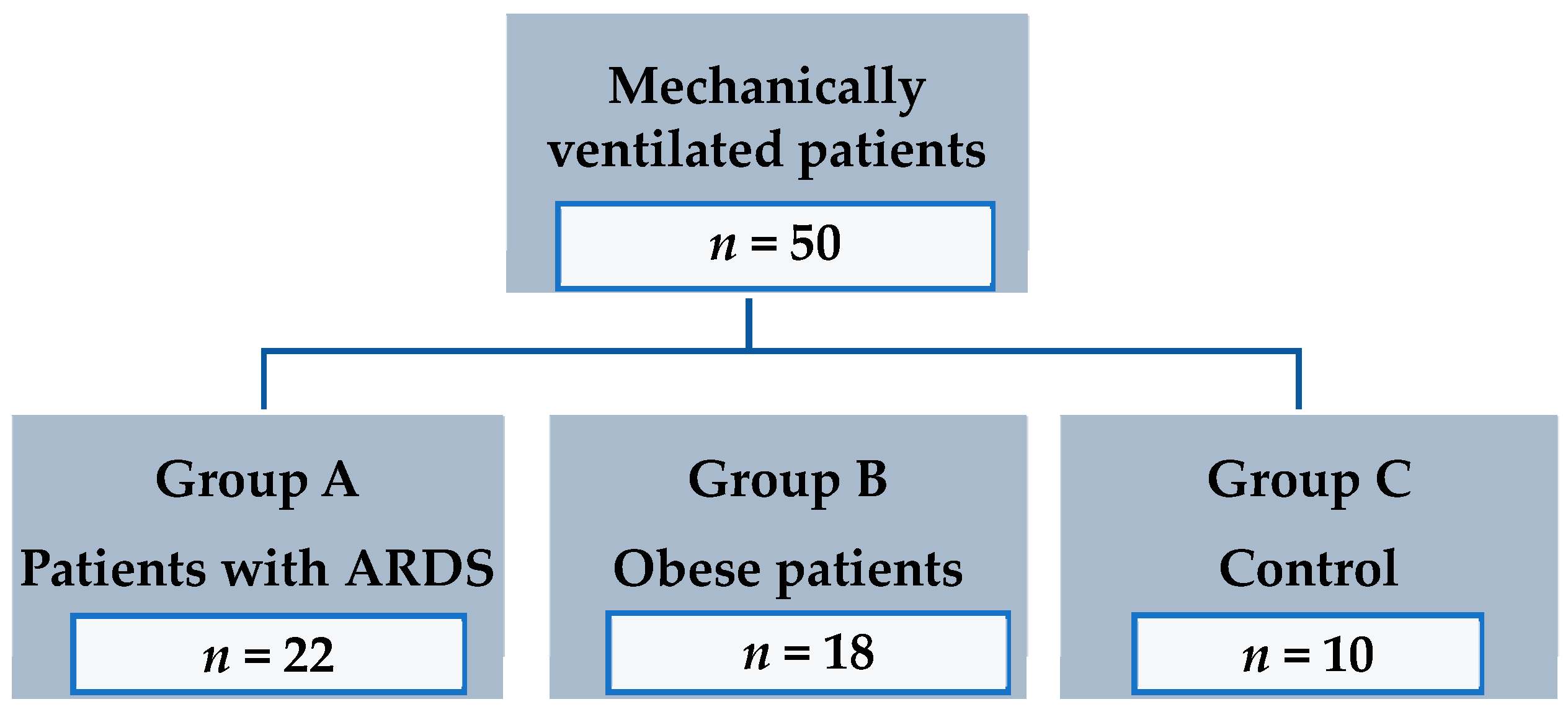
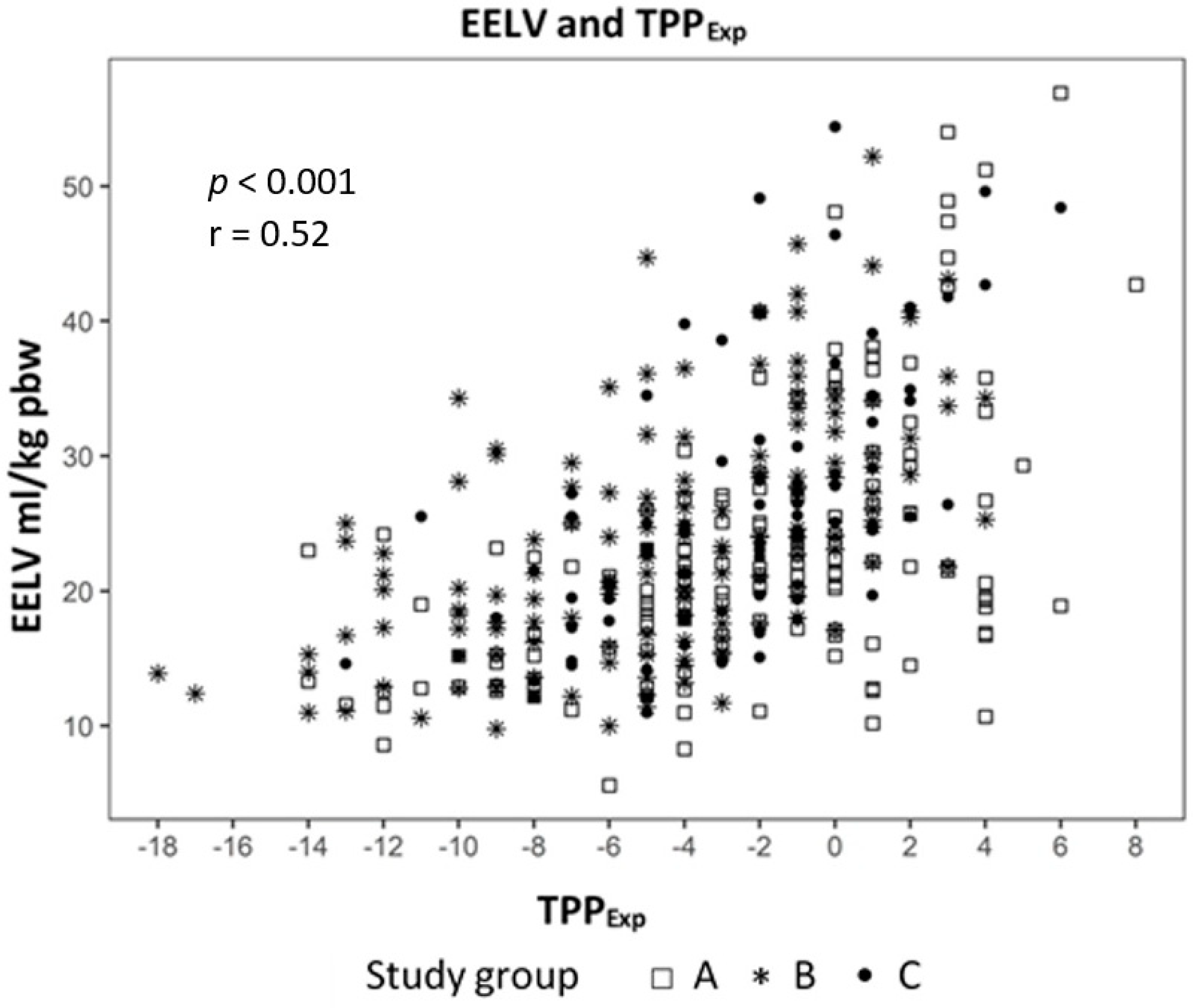
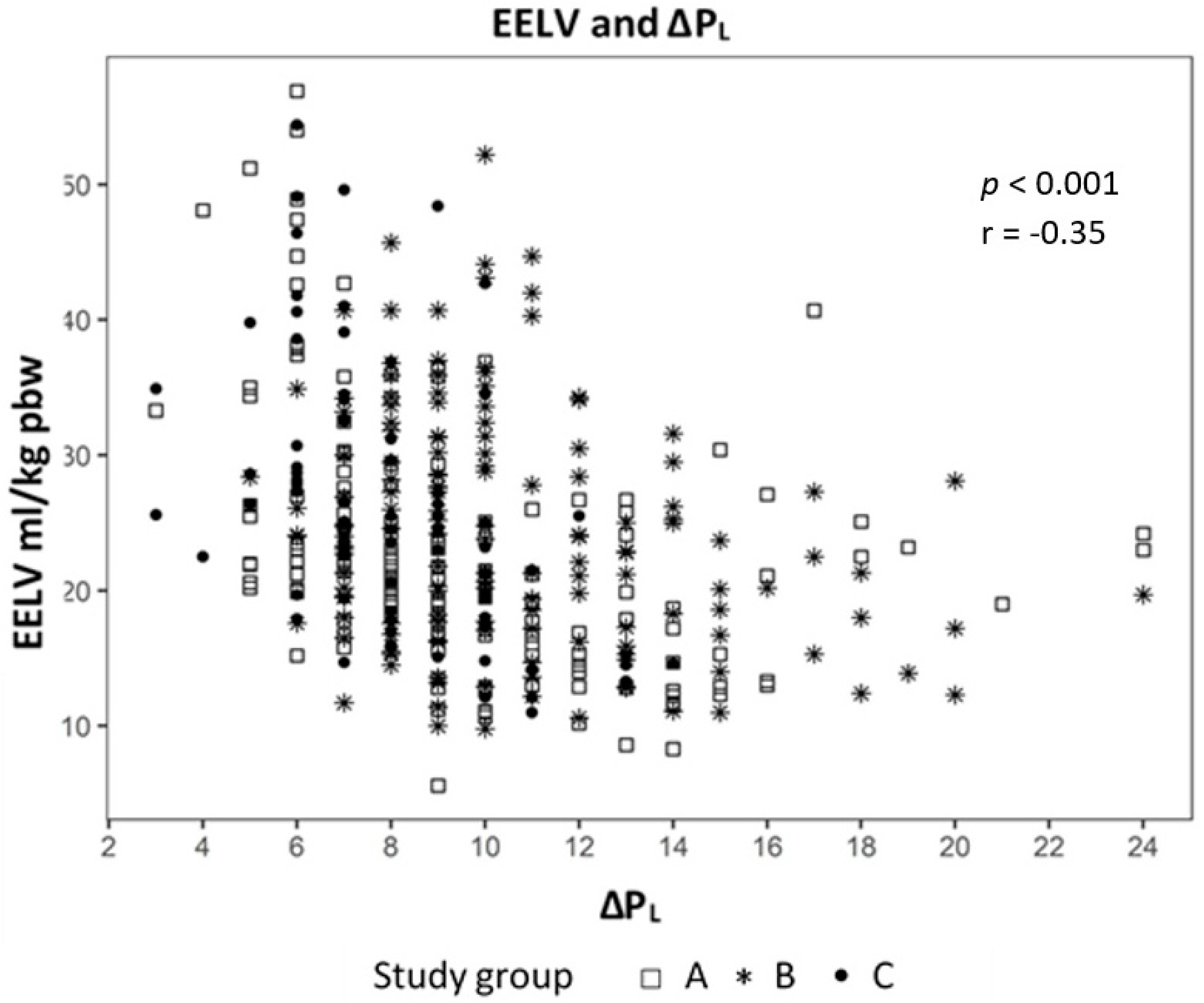
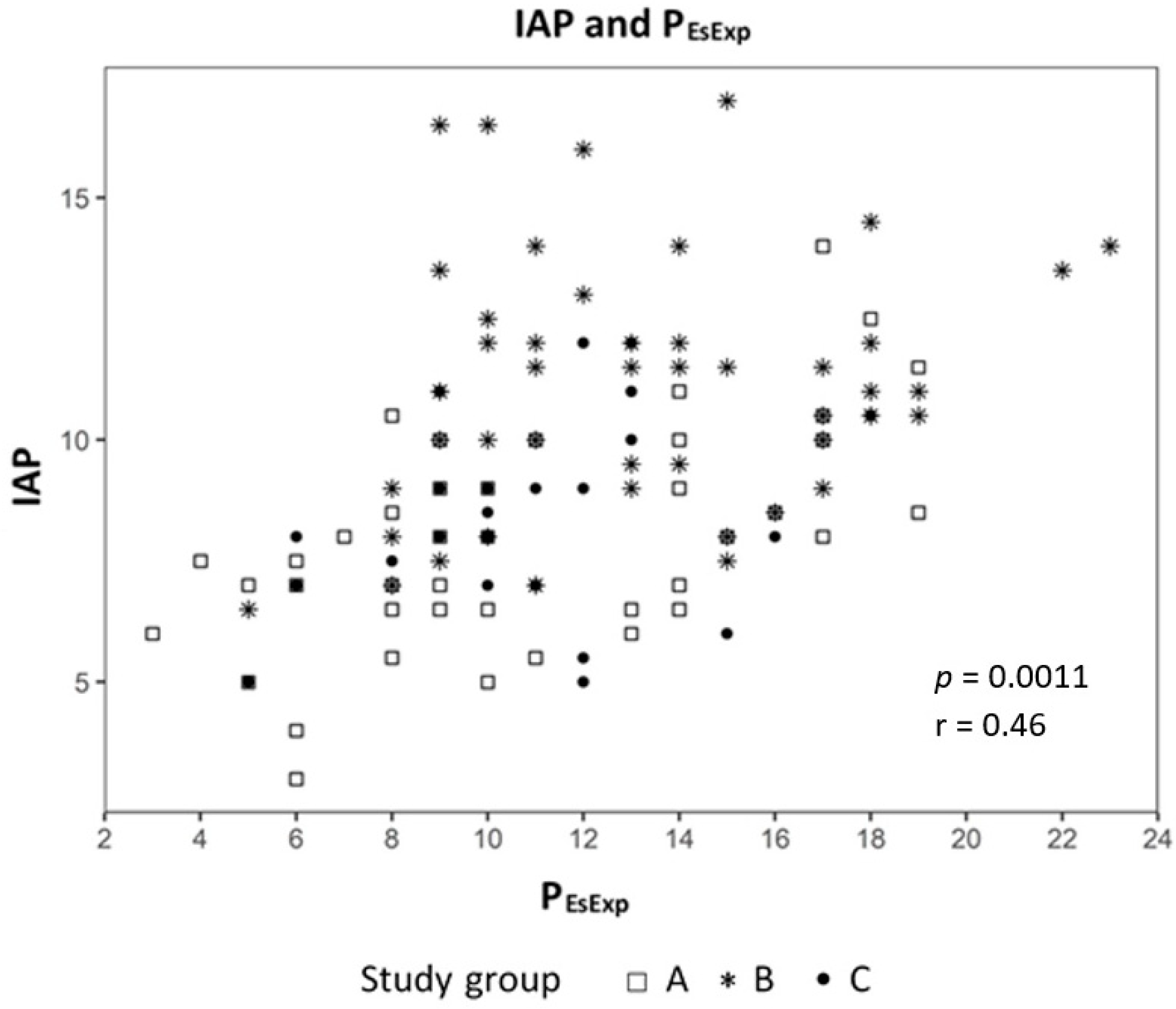

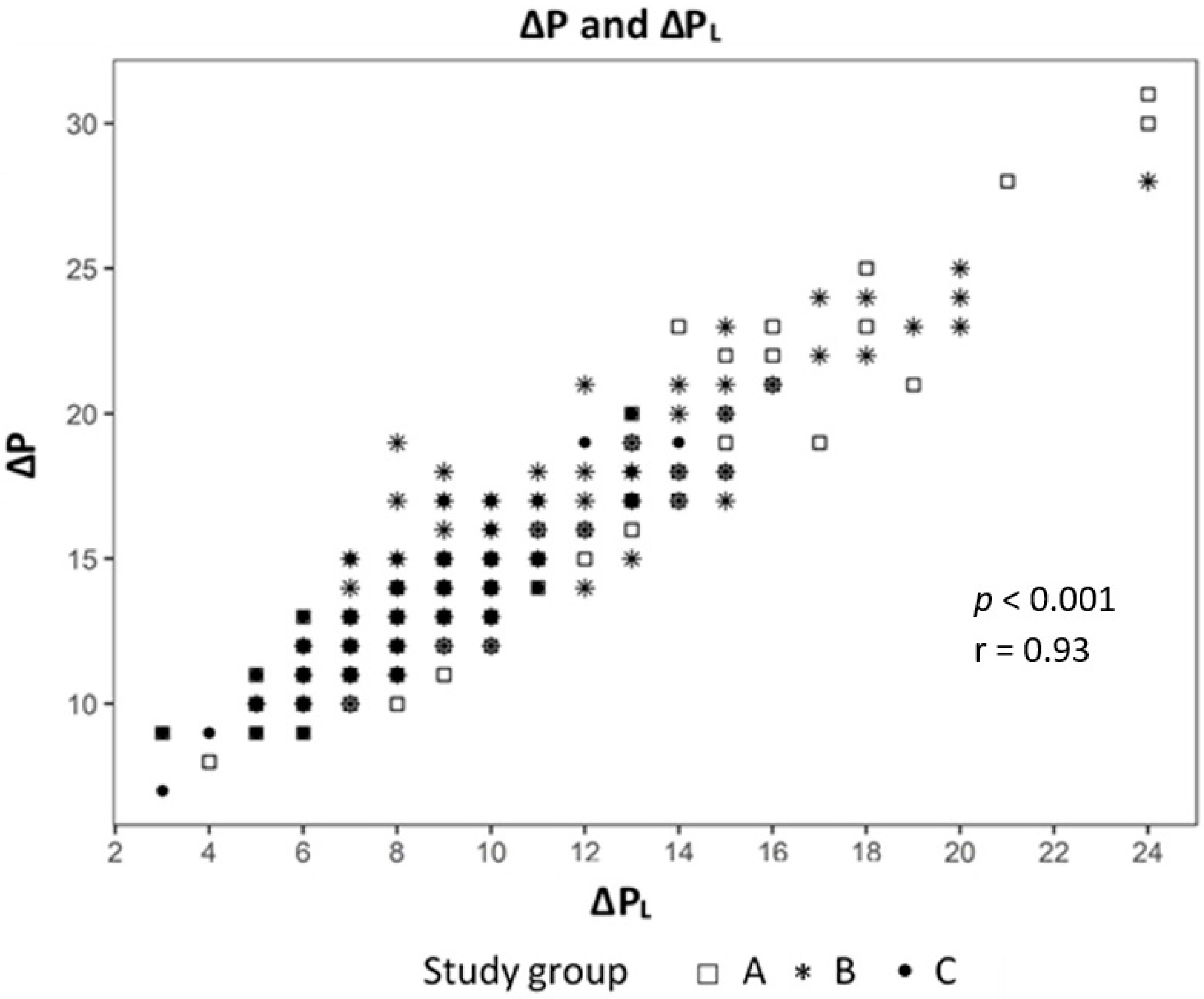
| Group A (n = 22) Patients with ARDS | Group B (n = 18) Obese Patients | Group C (n = 10) Control | |
|---|---|---|---|
| Demographics | |||
| Age | 64 ± 3 | 72 ± 3 | 72 ± 3 |
| Height (cm) | 173 ± 2 | 169 ± 3 | 175 ± 2 |
| Weight (kg) | 87 ± 4 * | 107 ± 6 + | 81 ± 2 |
| BMI (kg/m2) | 29 ± 1 * | 38 ± 2 + | 27 ± 1 |
| Male | 68% | 50% | 90% |
| Cardiovascular presentation | |||
| MAD (mmHg) | 78 ± 2 | 76 ± 2 + | 84 ± 3 |
| HR (bpm) | 85 ± 4 | 85 ± 3 | 87 ± 4 |
| SpO2 (%) | 96 ± 1# | 98 ± 0 | 98 ± 0 |
| etCO2 (mmHg) | 42 ± 1# | 41 ± 1 | 37 ± 2 |
| Norepinephrine μg/kgKG/min | 0.24 ± 0.05 | 0.17 ± 0.03 | 0.24 ± 0.06 |
| Ventilatory parameter | |||
| FiO2 (%) | 44 ± 2 *,# | 39 ± 1 | 38 ± 1 |
| VT (mL) | 424 ± 6 | 414 ± 6 | 433 ± 6 |
| VT (mL/kg pbw) | 6 ± 0 * | 7 ± 0 + | 6 ± 0 |
| RR (/min) | 19 ± 0 # | 19 ± 0 + | 18 ± 0 |
| MV (L/min) | 9 ± 0 | 9 ± 0 | 8 ± 0 |
| PEEP (cmH2O) | 14 ± 1 # | 15 ± 1+ | 11 ± 1 |
| PInsp (cmH2O) | 27 ± 1 *,# | 30 ± 1+ | 24 ± 1 |
| ∆P (cmH2O) | 12 ± 1 * | 15 ± 1 | 13 ± 0 |
| CStat (cmH2O) at PEEP 5 (cmH2O) | 60 ± 20 | 58 ± 22 | 62 ± 23 |
| Gas exchange | |||
| pH | 7,3 ± 0 # | 7,3 ± 0+ | 7,4 ± 0 |
| paCO2 (mmHg) | 59 ± 2 *,# | 51 ± 2 | 50 ± 2 |
| paO2 (mmHg) | 93 ± 3 * | 106 ± 3 | 96 ± 5 |
| P/F ratio | 210 ± 18 | 244 ± 15 | 232 ± 11 |
| PEEP | Group A (n = 22) Patients with ARDS | Group B (n = 18) Obese Patients | Group C (n = 10) Control | |
|---|---|---|---|---|
| Respiratory mechanics | ||||
| PInsp (cm H2O) | 5 | 20 ± 1 * | 23 ± 1 + | 19 ± 1 |
| 10 | 23 ± 0 * | 25 ± 1 + | 22 ± 0 | |
| 15 | 28 ± 0 *,§ | 30 ± 0 +,§ | 27 ± 1 § | |
| ∆P (cm H2O) | 5 | 15 ± 1 * | 18 ± 1 + | 14 ± 1 |
| 10 | 13 ± 0* | 15 ± 1 + | 12 ± 0 | |
| 15 | 13 ± 0 *,§ | 15 ± 0 +,§ | 12 ± 0 § | |
| ∆ PL (cm H2O) | 5 | 10 ± 1 *,# | 13 ± 1 + | 9 ± 0 |
| 10 | 9 ± 0 *,# | 10 ± 0 + | 7 ± 0 | |
| 15 | 9 ± 0 *,#,§ | 10 ± 0 +,§ | 7 ± 0§ | |
| TPPExp (cm H2O) | 5 | −5 ± 1 * | −8 ± 1 + | −6 ± 1 |
| 10 | −2 ± 1 * | −4 ± 0 + | −3 ± 1 | |
| 15 | 1 ± 0 *,§ | −1 ± 0 +,§ | 1 ± 0 § | |
| TPPInsp (cm H2O) | 5 | 5 ± 0 # | 5 ± 1 | 4 ± 0 |
| 10 | 7 ± 0 # | 6 ± 0 | 5 ± 0 | |
| 15 | 10 ± 1 #,§ | 9 ± 0 § | 8 ± 1 § | |
| PEsExp (cm H2O) | 5 | 10 ± 1 * | 13 ± 1 + | 11 ± 1 |
| 10 | 12 ± 1 * | 14 ± 1 + | 13 ± 1 | |
| 15 | 14 ± 0 *,§ | 16 ± 0 +,§ | 14 ± 0 § | |
| EELV (ml) | 5 | 1242 ± 85 | 1181 ± 64 + | 1440 ± 101 |
| 10 | 1541 ± 108 # | 1452 ± 73 + | 1880 ± 138 | |
| 15 | 1850 ± 119 #,§ | 1915 ± 97 +,§ | 2214 ± 154 § | |
| EELV (ml/kg pbw) | 5 | 18 ± 1 # | 19 ± 1 | 21 ± 1 |
| 10 | 22 ± 1 # | 23 ± 1 | 27 ± 2 | |
| 15 | 27 ± 1 *,§ | 31 ± 1 § | 30 ± 2 § | |
| ERS (cm H2O/mL) | 5 | 32 ± 3 * | 42 ± 5 + | 36 ± 6 |
| 10 | 30 ± 1 * | 38 ± 2 + | 28 ± 1 | |
| 15 | 31 ± 1 *,§ | 36 ± 1 +,§ | 29 ± 1 § | |
| EL (cm H2O/mL) | 5 | 24 ± 3 * | 32 ± 5 + | 22 ± 3 |
| 10 | 21 ± 1 *,# | 26 ± 1 + | 17 ± 1 | |
| 15 | 21 ± 1 *,#,§ | 24 ± 1 +,§ | 17 ± 1 § | |
| ECW (cm H2O/mL) | 5 | 10 ± 1 * | 12 ± 1 | 11 ± 1 |
| 10 | 10 ± 0 * | 12 ± 0 | 11 ± 0 | |
| 15 | 11 ± 1 | 12 ± 1 | 12 ± 1 | |
| IAP (cm H20) | 5 | 8 ± 0 * | 11 ± 0 + | 9 ± 0 |
| 10 | 8 ± 0 * | 11 ± 0 + | 9 ± 0 | |
| 15 | 8 ± 0 * | 11 ± 0 + | 9 ± 0 |
© 2020 by the authors. Licensee MDPI, Basel, Switzerland. This article is an open access article distributed under the terms and conditions of the Creative Commons Attribution (CC BY) license (http://creativecommons.org/licenses/by/4.0/).
Share and Cite
Fiedler, M.O.; Diktanaite, D.; Simeliunas, E.; Pilz, M.; Kalenka, A. Prospective Observational Study to Evaluate the Effect of Different Levels of Positive End-Expiratory Pressure on Lung Mechanics in Patients with and without Acute Respiratory Distress Syndrome. J. Clin. Med. 2020, 9, 2446. https://doi.org/10.3390/jcm9082446
Fiedler MO, Diktanaite D, Simeliunas E, Pilz M, Kalenka A. Prospective Observational Study to Evaluate the Effect of Different Levels of Positive End-Expiratory Pressure on Lung Mechanics in Patients with and without Acute Respiratory Distress Syndrome. Journal of Clinical Medicine. 2020; 9(8):2446. https://doi.org/10.3390/jcm9082446
Chicago/Turabian StyleFiedler, Mascha O., Dovile Diktanaite, Emilis Simeliunas, Maximilian Pilz, and Armin Kalenka. 2020. "Prospective Observational Study to Evaluate the Effect of Different Levels of Positive End-Expiratory Pressure on Lung Mechanics in Patients with and without Acute Respiratory Distress Syndrome" Journal of Clinical Medicine 9, no. 8: 2446. https://doi.org/10.3390/jcm9082446
APA StyleFiedler, M. O., Diktanaite, D., Simeliunas, E., Pilz, M., & Kalenka, A. (2020). Prospective Observational Study to Evaluate the Effect of Different Levels of Positive End-Expiratory Pressure on Lung Mechanics in Patients with and without Acute Respiratory Distress Syndrome. Journal of Clinical Medicine, 9(8), 2446. https://doi.org/10.3390/jcm9082446





